Nowadays, it seems that every business has a loyalty program. But have you ever considered what it actually costs to run one effectively? This article will break down the real costs associated with implementing and maintaining a loyalty program so you can make informed decisions about your business.
After reading this, you’ll have a much clearer picture of the financial investment required to run a loyalty program and be able to budget accordingly.
How much does a Loyalty Program really cost?
The loyalty program cost isn’t a one-size-fits-all situation; it really depends on the size and scope of your operation. Here, I will show you the overall cost structure of the loyalty program, setting it for two main categories: small-to-medium businesses and large businesses.
Cost of a loyalty program for small-to-medium businesses:
→ Total: $2,522.50 |
Cost of a loyalty program for large businesses:
→ Total: $4,485.00 |
Don’t worry if you find the above cost information ambiguous since this is just the summary of the total cost that you need to pay. Remember to read till the end, as I am going to break down the loyalty program cost calculation details below.
Cost of a loyalty program: A detailed breakdown
From the overview of the cost of a loyalty program above, now I’m going to present a detailed cost breakdown for small-to-medium business loyalty programs handling under 2,000 orders and contrast that with the expenses faced by large businesses processing over 7,000 orders.
Along with the analysis, I will include an example of the fees that you need to pay when using the Joy Rewards & Loyalty Program app during your loyalty program setup process.
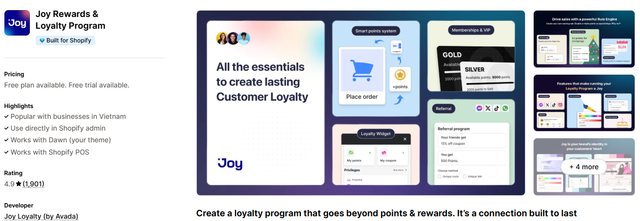
The Joy app is a customer loyalty program designed to help businesses drive growth through customer engagement. The app is designed to help businesses increase repeat purchases, customer lifetime value, and referrals. The app also aims to help businesses collect valuable customer data, differentiate themselves from competitors, and drive engagement and customer experience.
1. Small-to-Medium Businesses (<2,000 orders)
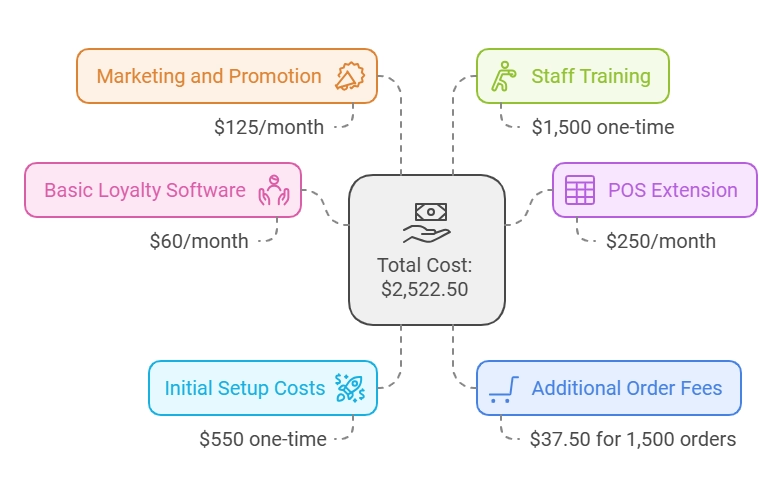
- Basic Loyalty Software ($60/month): Includes core features like point tracking, reward redemption, and basic analytics, typically with limited customization options.
Example: For small-to-medium businesses, Joy Loyalty Program offers a Professional plan for $24.99 per month, which includes up to 500 free orders. This is more affordable than the average cost of $45-$75 per month for basic loyalty software.
- POS Extension ($250/month): Covers integration with existing point-of-sale systems, allowing for seamless in-store and online point accrual and redemption.
Example: Joy charges an additional $15/month for POS features, which is significantly lower than the average $0-$500 per month. This makes it accessible for small-to-medium businesses to integrate loyalty across online and offline channels.
- Initial Setup Costs ($550 one-time): Encompasses program design, basic branding, and initial configuration of the loyalty software.
Example: Joy doesn’t charge setup fees, saving businesses the typical $100-$1,000 initial cost. This allows small-to-medium businesses to get started quickly without a large upfront investment.
- Additional Order Fees ($37.50 for 1,500 orders): Represents transaction fees, usually around 2-3% per order, covering payment processing and loyalty point allocation.
Example: Joy charges $15 per 100 orders beyond the free limit, which is in line with the industry average of 2-3% per transaction. This scalable pricing allows businesses to grow without sudden cost jumps.

- Marketing and Promotion ($125/month): Includes email campaigns, social media posts, and in-store signage to promote the program to customers.
Example: Joy includes basic marketing features in its plan, potentially saving businesses the typical $0-$250 per month for separate marketing tools. This integrated approach can be more cost-effective for small-to-medium businesses.
- Staff Training ($1,500 one-time): Covers initial training sessions for employees on program mechanics, customer service, and basic troubleshooting.
Example: While Joy doesn’t explicitly mention training costs, its user-friendly interface may reduce the need for extensive training, potentially saving on the typical $500-$2,500 one-time cost.
2. Large Businesses (> 7,000 orders)
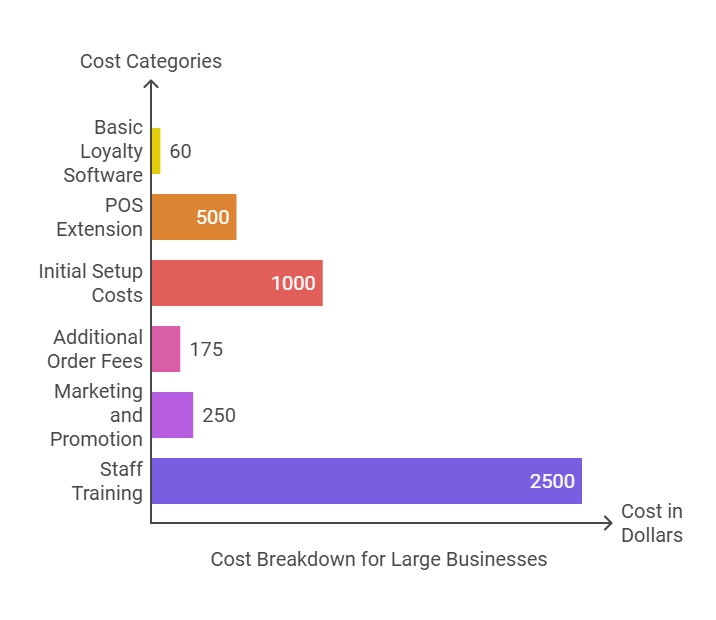
- Basic Loyalty Software ($60/month): Similar to small-to-medium businesses, but includes more advanced features like segmentation and multi-tier rewards.
Example: Joy’s Enterprise plan at $499/month caters to large businesses, including advanced features and higher order volumes. This is competitive compared to other enterprise-level solutions that can cost thousands per month.
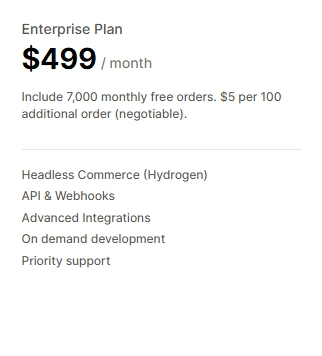
- POS Extension ($500/month): More comprehensive integration, potentially covering multiple locations and more complex inventory systems.
Example: The Enterprise plan of Joy includes POS features without additional fees, offering significant savings compared to the average $0-$500 per month for separate POS extensions.

- Initial Setup Costs ($1,000 one-time): Includes more extensive program design, custom branding, and potentially API integrations with existing systems.
Example: Joy’s Enterprise plan may include customization and setup support, potentially offsetting the typical $1,000+ setup costs for large-scale programs. This can provide a more tailored solution without excessive upfront costs.
- Additional Order Fees ($175 for 7,000 orders): Similar percentage to small-to-medium businesses, but with higher volume leading to increased total cost.
Example: Joy charges $5 per 100 additional orders on the Enterprise plan, which is lower than their small business rate and competitive for high-volume businesses. This sliding scale pricing benefits larger operations.

- Marketing and Promotion ($250/month): Covers more extensive marketing efforts, potentially including targeted ads and more sophisticated email campaigns.
Example: Advanced marketing features are included in the Enterprise plan of Joy Rewards & Loyalty Program, potentially saving on separate marketing tool costs. This integrated approach can streamline operations for large businesses.
- Staff Training ($2,500 one-time): Includes more comprehensive training, potentially covering multiple locations and more advanced program features.
Example: While not explicitly mentioned, Joy likely offers more comprehensive support for Enterprise clients, potentially reducing training costs and implementation time.
5 Hidden costs of a loyalty program
From what I’ve seen, setting up a loyalty program involves more than just the initial investment in technology and incentives; there are some underlying costs that can sometimes get overlooked. I think it’s best to have a complete picture of all potential expenses before launching a program. Therefore, I’ll be outlining some of the often-unseen costs associated with loyalty programs so you can make informed decisions.
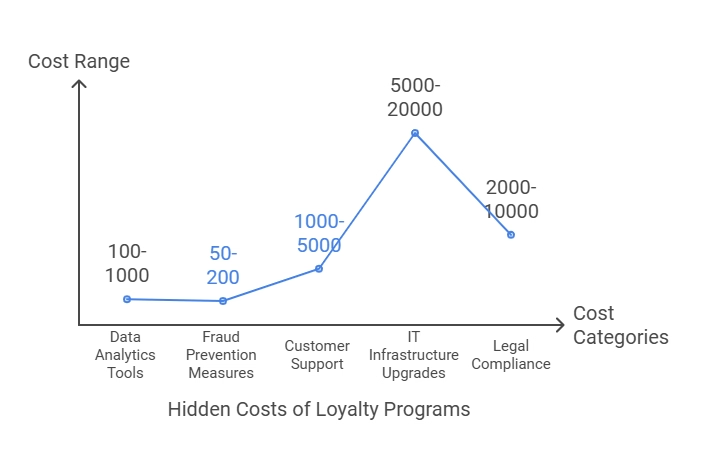
- Data analytics tools can set you back anywhere from $100 to $1,000 per month, depending on how deep you want to dive into customer behavior.
- Fraud prevention measures might cost you around $50 to $200 monthly, which I think is worth it to protect your program from abuse.
- Customer support for loyalty-related issues could run you about $1,000 to $5,000 per month if you need dedicated staff.
- Unexpected IT infrastructure upgrades to handle increased data load might hit you with a one-time cost of $5,000 to $20,000 – trust me, it’s a nasty surprise when it happens.
- Legal compliance costs for data protection can sneak up on you, potentially costing $2,000 to $10,000 annually, especially if you’re dealing with international customers.

5 Tips for Saving the cost of loyalty programs
Keeping loyalty program costs under control is crucial for ensuring a good return on investment. I’m going to share some practical tips that I’ve picked up to save money on your loyalty program.

- Start simple and scale up later: I think it’s a good idea to begin with a basic program and add more features as you grow. This way, you don’t overspend on fancy software or complicated rewards you might not even need at first. It’s like learning to ride a bike – you start with training wheels.
- Choose rewards strategically: Instead of giving away expensive items, consider offering things that don’t cost you much, like early access to sales, exclusive content, or free shipping. In my view, these kinds of perks can be just as appealing to customers, and they can also be good for your business.
- Leverage existing resources: Don’t rush out and buy a bunch of new tools if you don’t have to. See if you can use your current CRM, email marketing platform, or even your point-of-sale system to manage some aspects of your loyalty program. Using what you already have is a great way to save money.
- Focus on automation: Setting up automated emails for things like welcome messages, birthday rewards, or point balance updates can save you a lot of time and effort. I’ve found that automation is a real lifesaver for small businesses because it frees up your time to focus on other important things.
- Track your program’s performance closely: Keep a close eye on which rewards are being redeemed most often and which marketing efforts are driving the most sign-ups. This data will help you optimize your program and make sure you’re not wasting money on things that aren’t working. It’s like checking the map on a road trip; you want to make sure you’re on the right track.
To sum up
This article has outlined the various costs associated with creating a loyalty program, from software and technology to rewards and marketing. My advice would be to carefully weigh these costs against the potential benefits of increased customer loyalty and repeat business, as this analysis will help you determine if a loyalty program is a worthwhile investment for your specific business.
FAQs
How much does it cost to have a loyalty program?
The cost varies widely, ranging from free plans to hundreds of dollars per month, depending on the platform, features, and business size.
How to calculate loyalty program cost?
To calculate the loyalty program pricing, consider software fees, rewards value, operational expenses, and additional marketing or management costs.
How do you budget for a loyalty program?
Set a budget by analyzing customer retention goals, expected ROI, program costs, and the percentage of revenue allocated for rewards.
Do you pay for loyalty programs?
Yes, businesses often pay for loyalty program software, rewards, and maintenance, though some platforms offer free versions for basic use.
How much do companies spend on loyalty programs?
Companies typically spend 2-5% of their annual revenue on loyalty programs, depending on their goals and the program’s scale.
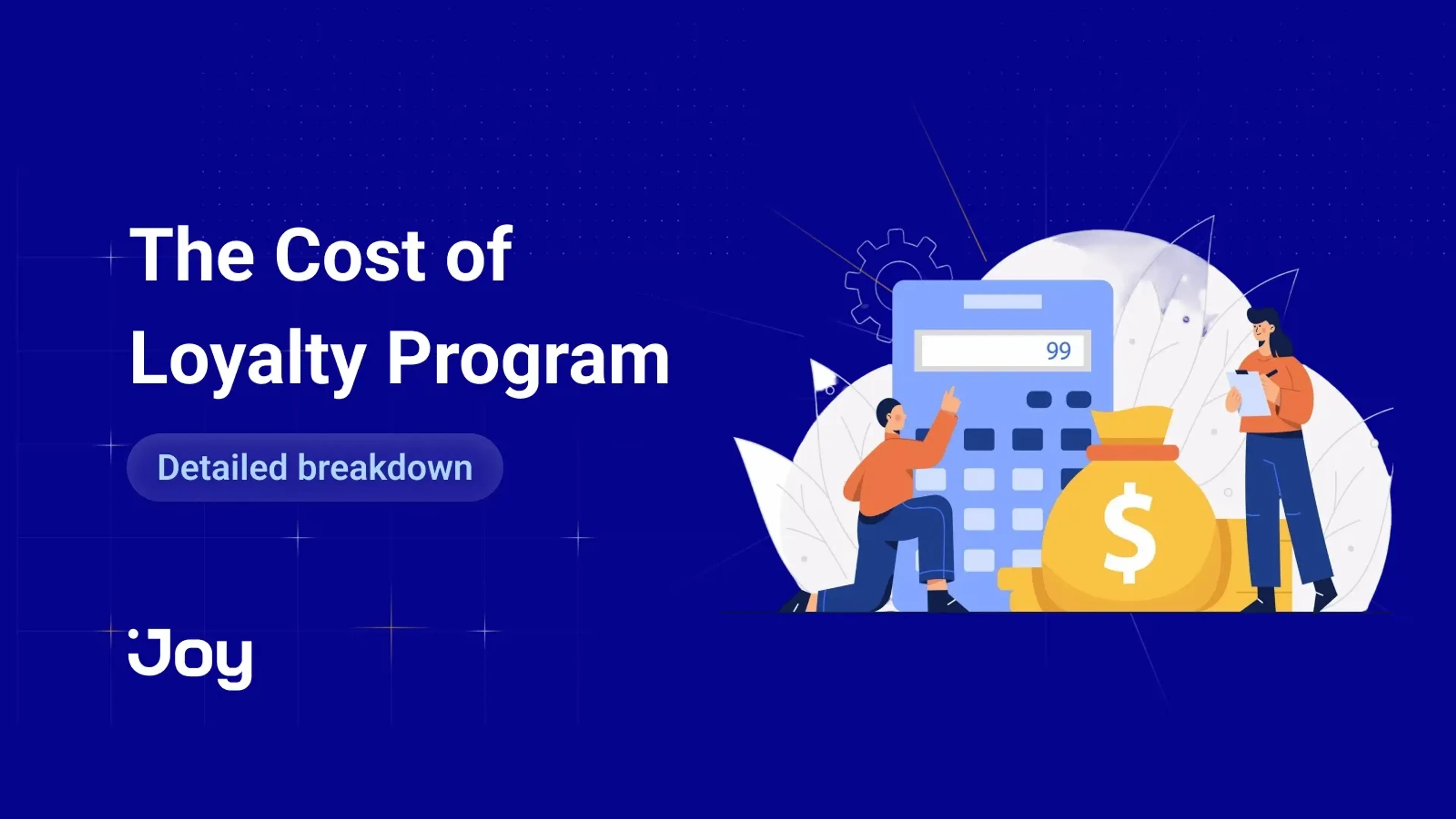



-a7e9a3.png?width=828&q=75&f=webp&auto=format)